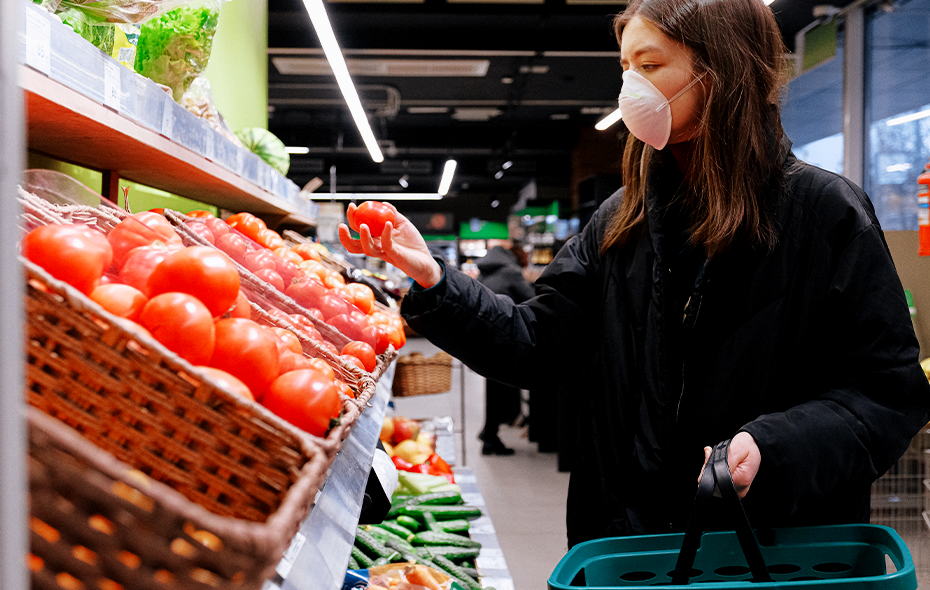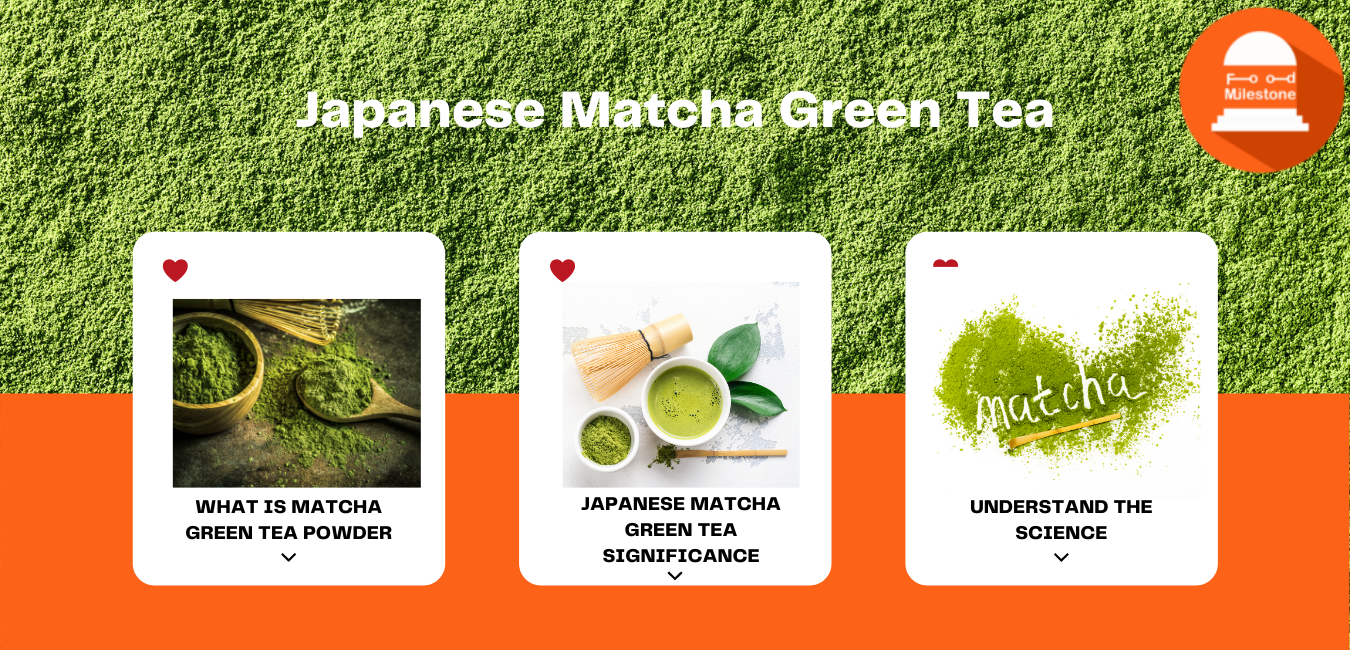Overview
Tea is one of the most taken up drinks, 2nd only to water, in several cultures. Its distinctive taste, fragrance, and health-promoting effects are very valued around the world, as are its socio-cultural significances.
Japanese Matcha Green Tea among the family of green tea has gained popularity over the years.
What is Matcha Green Tea Powder or Japanese Matcha?
Matcha Green Tea is finely ground powder of notably grown and refined Japanese green tea (Camellia sinensis) of the Tencha selection, grown in a traditional/conventional way. The popular beverage has caught sight of all over the world.
It is specifically abundant in antioxidant substances as a result of the unique plantation technique. According to the traditional technique, for the majority of the development duration, the tea bushes are covered utilizing bamboo mats to shade the fallen leaves from too much direct sunlight.
During this shading process, plants have the ability to generate greater amounts of amino acids and also bioactive compounds, consisting of chlorophyll as well as theanine, responsible for the special, non-bitter preference and the characteristic, lively color of matcha green tea.
Shading enhances the processes of synthesis and accumulation of biologically active compounds, including theanine, caffeine, chlorophyll, and various types of catechins.
Therefore, matcha green tea is extremely valued for its quality and also regarded as one of the most fragrant green tea.
Matcha Green Tea, which can have a bitter and verdant taste, is usually offered with a sweetener or milk. Matcha Green Tea powder is also popular in smoothie mixes and also cooking.
Japanese Matcha Green Tea Significance
The conventional Japanese tea ceremony centers on the prep work, offering, and drinking of matcha as warm tea, and also symbolizes a reflective spirituality. In modern-day times, matcha is likewise used to add flavor and also dye foods, such as mochi and also soba noodles, green tea gelato, matcha cappucinos, as well as a selection of Japanese wagashi confectionery. Matcha made use of in custom ceremonies is referred to as ceremonial-grade, meaning that the powder is of a high sufficient high quality to be used in the tea ceremony. Lower-quality matcha is referred to as culinary-grade.
Blends of matcha are given poetical names referred to as chamei (“tea names”) either by the producing planting, shop, or developer of the mix, or by the past master of a certain tea tradition. It becomes known as the master’s konomi when a mix is named by the grand master of a tea event lineage.
Self Explanatory Matcha Green Tea Benefits? | Understand the Science of Green Tea
The health advantages of green tea occur from the existence of all-natural anti-oxidants, like polyphenols: wide variants of compounds making up as much as 30 percent of the completely dry weight of green tea. Polyphenols are thought to be incredibly effective antioxidants, with results similar to those of vitamins, such as vitamins C as well as E, carotene, as well as tocopherol. The amounts of health-promoting active compositions had in tea drinks rely on the type of tea, the quantity of tea leaves per section, brewing temperature, and time.
Content of Catechins in Matcha Tea
Studies validating the high antioxidant capacity of tea drinks declare that it stems from the substantial significance of catechins, a type of phenolic substance with valuable results on human health.
Green tea consists of 4 major catechins, i.e., (−)- epicatechin (EC), (−)- epicatechin-3-gallate (ECG),( −)- epigallocatechin (EGC), and also (−)- epigallocatechin-3-gallate (EGCG), of which the last is one of the most active and also plentiful. The high polyphenolic composition has a higher strength for scavenging free radicals than vitamin C on its own. Phenolic substances take place naturally in the leaves of Camellia sinensis. Matcha might for that reason be described as a significant source of catechins in daily human diet regimen.
Content of Caffeine in Matcha Tea
High levels of caffeine is a vital part of tea drinks and are responsible for their unique and also preferable preference. At the same time, it is an effective antioxidant contributing to the antioxidant possibility of the beverage.
Its degree might be related to the time of harvest and age of leaves– the older the fallen leaves, the reduced the caffeine material. The high levels of caffeine material additionally rely on tea selection, climate conditions during vegetation, along with the brewing technique.
The effects of caffeine are embedded in its antioxidant capacity, counteracting reactive oxygen species, and also boosting antioxidant enzyme activity as well as complete glutathione degrees. In normal dosages, caffeine might reduce consistent oxidative anxiety, lowering the prevalence of totally free radical-mediated diseases.
Furthermore, caffeine might hinder the secretion of proinflammatory cytokines, showing anti-inflammatory impacts.
Matcha has a moderately high caffeine composition compared to various other green teas, which offers it a unique fragrance as well as flavor. The composition of high levels of caffeine in green teas was located to fall within the range of 11.3– 24.67 mg/g [32], while in matcha it accounted for between 18.9 and also 44.4 mg/g. For the interest of a comparison, a lot of coffee beans will consist of 10.0– 12.0 mg caffeine/g of beans.
Content of Phenolic Acids in Matcha Tea
Phenolic acids are subsidiary plant metabolites, qualified by high antioxidant and also anti-inflammatory potential, in addition to neuroprotective and hypoglycemic results.
They have actually likewise been reported to prevent cancer cell growth as well as stop metastasis.
Some phenolic acids, with regulating lipid and also carbohydrate metabolism, might sustain the guideline of metabolic disorders. Among the most usual substances from this group discovered in foodstuffs is chlorogenic acid.
In research by Koláˇcková et al., the overall composition of phenolics in alcoholic extracts was identified to reach up to 273 mg GAE/g. A detailed evaluation revealed the following maximum degrees of phenolic acids in matcha tea samples, differing in regards to different requirements, including origin: gallic acid– 423 µg/ g, p-hydroxybenzoic acid– 243 µg/ g, chlorogenic acid– 4800 µg/ g, caffeic acid– 223 µg/ g, ferulic acid– 289 µg/ g and also ellagic acid– 371 µg/ g.
Content of Rutin in Matcha Green Tea
Rutin, which in turn is a polyphenolic compound, is a powerful anti-oxidant. Its synergistic communication with ascorbic acid may enhance the protective effects of both substances in the cardiovascular system, enhancing blood vessels. It also has antidiabetic as well as anti-inflammatory profiles, therefore preventing diabetes-related pathologies. Its antioxidant and anti-inflammatory activity offers the possibility for avoiding conditions of free-radical or inflammatory origin, additionally neurodegenerative problems.
According to Jakubczyk et al., matcha green tea has an exceptionally high rutin material, contrasted to various other teas offered on the market. The authors contrasted the degree of rutin located in matcha (1968.8 mg/L) keeping that in buckwheat (62.30 mg/100 g), the last being identified as one of the richest resources of rutin in the human diet, and demonstrated that matcha tea may be a much better source of the substance than other foods. The findings made by Jakubczyk et al. appear to be regular with the observations of Koláˇcková et al.
Content of Quercetin in Matcha Green Tea
Quercetin is phytochemical with antioxidant and also neuroprotective activity. Furthermore, it was observed to stabilize the carbohydrate metabolic process by preventing sugar absorption from the gastrointestinal tract, controlling insulin secretion, and also improving insulin level of sensitivity in cells. What is more, the combination of quercetin with (−)- epigallocatechin gallate (EGCG) might boost the anticarcinogenic impacts of both.
The content of quercetin in the aqueous essence of matcha was determined by Schröder et al. at 1.2 mg/mL, which is partially higher than in typical green tea (1.1 mg/mL).
On the other hand, Koláˇcková et al. figured out quercetin levels in alcoholic removes reaching up to 17.2 µg/g.
Content of Vitamin C in Matcha Green Tea
Vitamin C is an effective exogenous antioxidant. As a result of its abilities, it strengthens the immune defense of the body. It really is an essential micronutrient in human nutrition which must be provided daily in appropriate amounts.
Jakubczyk et al. showed that infusions of matcha tea consist of from 32.12 to 44.8 mg/L of vitamin C, depending upon the temperature level of water used to prepare the mixture and the sort of tea.
In the study by Koláˇcková et al., matcha was located to consist of more than double the quantity of vitamin C of various other environment-friendly teas. Its composition was identified at 1.63– 3.98 mg/g, depending on the type of product and its origin.
Content of Chlorophyll in Matcha Green Tea
Thanks to shade-growing, matcha tea has enhanced chlorophyll content, which is in charge of its distinct vivid color. Chlorophyll and its derivatives show strong antioxidant and anti-inflammatory tasks.
The levels of bioactive substances, including chlorophyll, in the Tencha-type tea leaves which are used particularly for matcha, were established by Ku et al.
The degree of chlorophyll in Tencha leaves was higher than in conventional eco-friendly tea, amounting to 5.65 mg/g as well as 4.33 mg/g, respectively.
Content of Theanine in Matcha Green Tea
Theanine is actually an amino acid located in the tea plant Camellia sinensis. Because of the shade growing of plants planned for matcha production, theanine does not break down. Therefore, Tencha leaves consist of larger amounts of them compared to various other teas.
The fairly high theanine composition in matcha tea is in charge of its distinct non-bitter taste, as well as in combination with caffeine offers the taste sensation and also umami attribute of this kind of tea. The combination of l-theanine and also caffeine might boost concentration, alertness, and also performance to a greater level than the use of either substance alone, in addition to minimizing stress.
According to Kaneko et al., the content of l-theanine in matcha tea mixtures totals up to 6.1 mg/L [50], while Unno et al. located as long as 44.65 mg/g of that compound in matcha tea samples.
Grades of Matcha Green Tea Powder
Business considerations, particularly outside Japan, have actually significantly seen matcha marketed according to “grades”, suggesting top quality.
Of the complying with terms, “ceremonial quality” is not identified in Japan; “food grade” or “culinary quality” certainly is.
As a whole, matcha is costly contrasted to various other types of green tea, although its price relies on its quality. Greater qualities are costlier as a result of the manufacturing approaches and also more youthful leaves made use of, and thus they have an even more delicate flavor, and also are extra suited to be delighted in as tea.
Now let us talk about the three most discussed grades of matcha.
1. Ceremonial grade
2. Premium grade
3. Cooking/culinary grade
Does Japanese green tea have caffeine?
As compared to other forms of green teas, Japanese green teas generally have a higher amount of caffeine content as a result of the mild steaming process.
Nevertheless, the effects of high levels of caffeine in distinction to green tea are divergent from those within coffee as caffeine from tea is metabolized in a different way by the body. While caffeine in coffee provides you a quick, brief shock of energy, the high levels of caffeine in tea are bound to anti-oxidants which reduces absorption by the body.
In return, you actually get a steady and also a supply of high levels of caffeine for a lasting time period. This enables the body and mind to take pleasure in long-lasting, wellness alertness without the jitteriness often experienced from coffee.
One mug (237 ml) of basic Japanese matcha green tea, made from 4 tsp of powder, generally packs regarding 280 mg of high levels of caffeine. This is dramatically greater than a mug (237 ml) of normal green tea, which gives 35 mg of caffeine.
Nevertheless, most people don’t drink a complete cup (237 ml) of matcha at the same time as a result of its high caffeine properties.



